
Blog
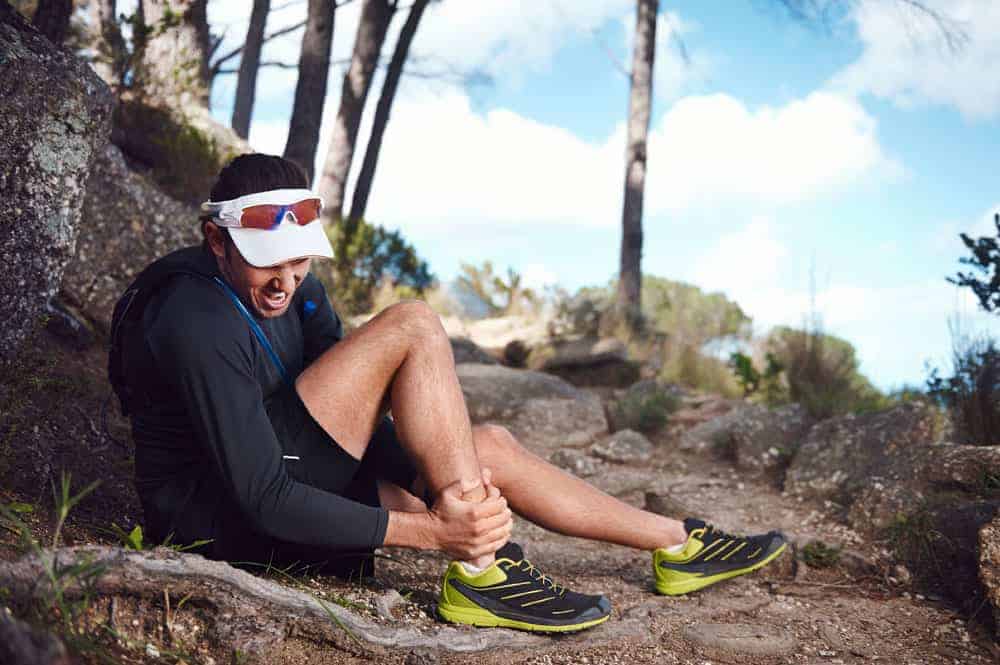
Your guide to rock-solid ankle stability
Your feet and ankles are the foundation of your body so imagine the persistent feeling that your ankle is going to “give away” or actually having your ankle collapse under the weight of your body? Ouch!
Sports podiatrist and founder of A Step Ahead Foot + Ankle Care Dr Brenden Brown explains, “Ankle instability is that uneasy feeling that your ankle is going to roll out, particularly when walking or running on rough surfaces.
“We tend to think of these ‘rough’ surfaces as being a rocky terrain or very unsteady ground but for someone who has had a previous ankle sprain, a rough surface can simply be a bump in a soccer field.”

So what are some key points about ankle instability?
- Having an ankle sprain increases the chance of another ankle sprain
- Those people who have an ankle sprain but don’t undergo physical therapy and rehabilitation are significantly more likely to re-sprain
- Repeated spraining or injury to the ankle can lead to chronic ankle instability (this can seriously effect quality of life)
- In fact, 33% of people with first time ankle sprains go on to develop chronic ankle instability.
- You can’t cure ankle instability by doing nothing. Evidence suggests it’s very unlikely it will get better by itself.
- Stopping exercise or playing sports won’t alleviate ankle instability but could cause other negative health impacts.
While many people underestimate the impact of ankle instability and simply don’t pay their ankles the attention they deserve, other causes include hyper-mobility (being double jointed), a very high foot arch and weak muscular control in a single leg.
Treating ankle instability
“When it comes to treatment, it’s important to note that it’s not just about the ankle – you need to consider the whole limb,” says Dr Brenden.
“Unfortunately, there’s also the common misconception amongst many health professionals that a single style of treatment will make ALL ankle sprains better. This isn’t so; treatment should be tailored to the type of sprain.
“Similarly, there’s the misunderstanding that wearing an ankle brace or taping the ankle will prevent ankle instability. Not so.
“We’re finding that the entire leg, in particular the glutes and all the muscles above the ankle are more vital than we ever thought before.
“If you have weak glutes or poor hip function on your left hand side you’re significantly more likely to twist your left ankle.”
Aside from just focusing on the ankle itself, Dr Brenden says there’s a growing body of evidence to support strength work through exercise.
This involves firstly identifying where the muscle imbalance is coming from and then performing targeted strength exercises.
“I have a real problem with healthcare practitioners who only ever tell people with ankle instability to do calf raises. If you’re a tennis player, calf raises are inappropriate because you’re jumping side to side rather than raising the feet up and down.
“Rehabilitation exercises need to be specific to the sport you play. You can’t take a ‘one-size-fits-all’ approach.”
Other methods of treatment include:
Footwear— A firm base and firm heel counter (we’re talking good quality trainers) is important while the ankle is unstable.
Orthotics—There’s a sound body of evidence that suggests looking at foot posture can be helpful. Over use of the muscles can affect the way the foot moves and, if left untreated, this can lead to ankle instability.
“The vast problem is that people delay treatment and end up having multiple ankle sprains, which not only damages the anterior talofibular ligament (ATFL) but the surrounding muscles as well.”
Ultimately, poor ankle stability can lead to a chain reaction of injury so it’s important to talk to your local podiatrist to find out the best method of action.
A Step Ahead Foot + Ankle Care is one of Sydney’s leading foot and ankle clinics. Principal podiatrist and founder of A Step Ahead Dr Brenden Brown (AKA Dr Foot) has been taking care of people’s feet for more than 20 years. With a background in sports medicine and having served as a former president of the Australasian Podiatry Council, Brenden is a wealth of information when it comes to foot and ankle care.
Find out more about ankle sprains and how to treat them
Got a question? Check out our Instagram profile #AskDrFoot
Or simply tune into our Facebook page for regular live videos and updates on the latest foot and ankle advice from the experts.

Heel Pain, Uncategorized
Is wearing a Moon Boot going to help Heel Pain?

Should I wear a “Moon Boot” for heel pain?
The Answer?
NO, but why? Its best to settle on some understandings from the beginning. It is widely understood that it is “soft tissue and tendons that are what become sore in Heel Pain. The idea that Heel Spurs “cause” pain has been debunked and proven incorrect a number of times!
Over the last few years there has been an evolving understanding around how tendons and soft tissue works. Keep this in the front of your mind – “TENDONS HATE CHANGE”. Stopping all activity if you are currently active is a sure-fire way to ensure that when you return to your activity you will also see the return of your heel pain!
Boots can “Change” tendons – in a negative way!
As we said stopping all activity is not good for us. That same principal exists for those who are using an air cast or moon boots. Completely removing the function of the foot and calf will mean these muscles will most likely fatigue and lose condition. At best, you will need a delicate and dedicated rehab process to get you back to normal function.
This includes “tears” in fascia’s! We have found there is an ever-increasing body of evidence suggesting that many radiologically identified tears maybe completely normal and part of a normal aging process!
Patients often ask us at the clinic about “booting” or casting them after “a friends” practitioner did this with them their “friend”. All the evidence base suggests that this is often the wrong way forward. In good conscience, we can’t do this. It should be recognized this was once accepted practice, we know we did it!
However the evidence base suggests doing this will unload the soft tissue completely and can in itself start another chain of events and problems which you only have to overcome later! So NO BOOT!
If by chance you are reading this and you’ve been prescribed a boot. I’d respectfully ask your practitioner about what the current evidence base says about this method of treatment?
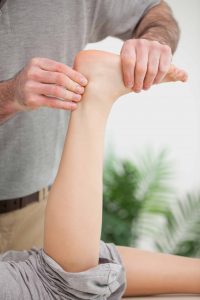
Should I change my activity?
You SHOULD make modification to activity; however, a complete stop will mean you either
A. Need to rebuild your activity over quite an extended time.
or
B. Your heel pain is likely to return!
For the moment STOP Jumping of and onto things. For example, on + off a truck, box jumps at exercise class, skipping or other high intensity impacting the heel and forefoot until we have you back to comfortable. We will then slowly load you back up to these activities. As a guide if it hurts STOP IT!
What do I do instead?
Our strong advice is to look for strong supportive cushioned footwear.
What does this mean? Look for the following in Sneaker style or work boot.
1.Always lace up!
2.Bend only at the toes
3.Shoes should NOT bend in the middle!
4.Should NOT twist or wring out
5.Firm heel counter (back of shoe that hugs the heel)
Wear your lace up shoes – From the moment you wake – till the moment you head to bed! No matter inside or outside! No thongs – NO bare feet! This is a far better way of providing the tendons and other soft tissue structures support without immobilizing the foot and creating more problems.

Need some help?
Our Doctors at A step ahead see between 8 – 12 heel pain patient each every day! Heel pain , sports injuries and musculoskeletal pain in feet + lower legs are our passion. We are often for many people the 2nd, 3rd or even 4th opinion for their heel pain. We are most often the last!
First steps to getting back to pain free?
Give our front desk team a call, they speak to dozens of people a day just like you with problematic heel pain. They will run through with you what you may have tried so far and get a better understanding of your pain. They will then help work out what type of appointment is best to make for you. From here they can reserve your appointment time.
We would LOVE to be able to help you on the way back to becoming Happy Healthy + active.
Our number is 96732987 or 47322007 we look forward to helping you
If you are looking for more information we have a prepared a dedicated page to helping both other practitioners and patients with information on HEEL PAIN. ” Heel Pain Doctor ” has loads of fact and helps busts some of the myths around heel pain.

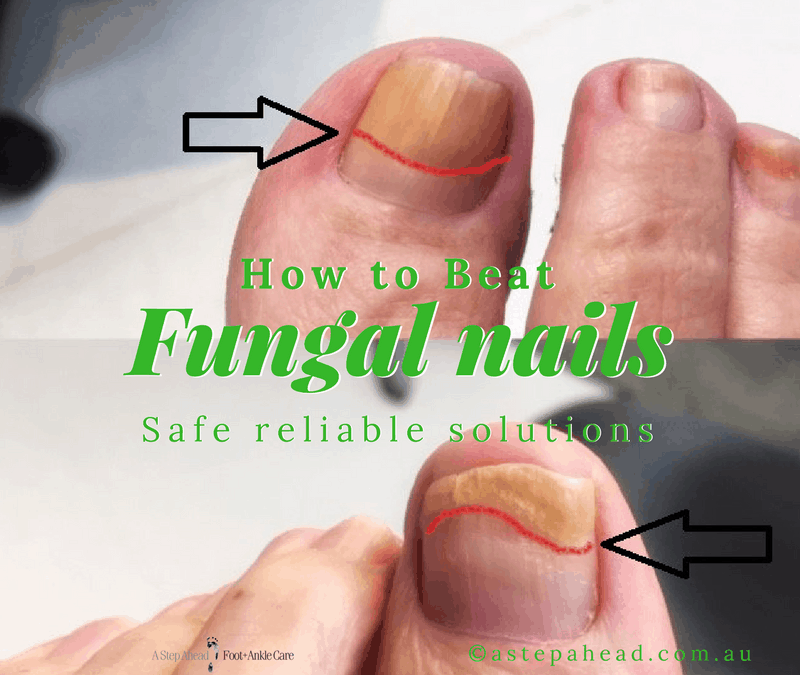
Blog, Fungal Nails
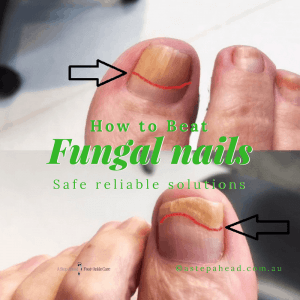
Before the Laser therapy the entire nail was yellow and infected
How do you beat fungal nail infections?
Tanya was frustrated!!
“I have tried everything! Its driving me crazy!”
“I have tried Vicks”
“I have tea tree oil”
“I think I have tried all the ointment creams and paints that the pharmacy stocks”
“I have even tried toothpaste!!!”
“I can’t kill this nail Fungus!!!”
This is what Tanya said to us when she attended our clinic. Frustrated and embarrassed Tanya is not alone in feeling this way. Nail fungus can be embarrassing and yes it can take years and years to beat and for many people they never do, until now.
What do Fungal nails look like ?

Fungal nails before therapy – this is an extreme case and what nails may look like without treatment
Yellow, Brittle, worm eaten, unsightly, a single line though the nail to an entire worm eaten slightly smelly mess is what a fungal nail can look like. It often starts small, a slight and small line developing in the nail. It may look like the nail is lifting and you may think you simply bumped it.
Accurate diagnosis can be frustrating while you may self-diagnose the condition after looking at “Dr Google” it can be easy to find photos and information on the net. Asking friends and relatives will help as well (Let’s face it everyone’s an expert and everyone has a cure!) However lots of people find that on visiting their GP that despite testing the results often come back negative – yes despite those yellow worm eaten toenails! Now there’s a reason for that, if you’d like click this link it may help explain why. https://astepahead.com.au/fungal-nail-with-false-negative-results/
So after you’ve tried all the paints and ointments from the pharmacy, all the home remedies from Vicks to tooth paste. Where do you go to from here?
An answer for stubborn nail fungus
After many years in Podiatry and feeling the frustration of literally tens of thousands of patients I took the decision to look for a solution to chronic fungal toenails. Each year I see literally hundreds of patients who have struggled with this horrible condition and yes many of these patients have tried multiple creams lotions and medicament with no relief just like you! Frustrated by this and along with some Podiatry friends, I decided to look worldwide for a solution that would be safe simple and pain free for patients.
Laser is now used to kill fungal infections in nails

Laser therapy for fungal nails is a fast effective and reliable solution to fungal nails
In search of an answer I attend a conference in America and after some research found the Class 4 Diode laser which we introduced almost 3 years ago now. Finally we had found an answer which provided patients with simple and safe solution to a complicated problem.
Laser therapy is a highly effective treatment for this embarrassing and health effecting problem. Our clinical effectivity rate is well over 85% and reaching 95%. We hear of others using laser with lesser result and we believe it, we have developed a detailed system of after care to help you keep the fungus away! But more on that later!
A summary – why choose laser:
- Highly effective – Fast results
- Safe – No side effects!
- No Aesthetic required
- Comfortable with minimal discomfort – think laser hair removal.
- Nail Polish can be applied immediately after you leave
- No need to take medication
So what after all of Tanya’s frustration did we do?
We undertook a laser session with Tanya, laser takes approximately an hour , yes it can be a little uncomfortable , most patient who have experienced it compare it to laser hair removal. We then treated Tanya’s shoes and helped her with how to beat the fungus at home and from returning.
We held a free check-up for Tanya at 2 months after our initial treatment and she was ecstatic! After 7 years her nails had developed a clear line where new FUNGAL free toe nail had started to grow!!!!
We went through again what steps she could take to stop this from re occurring however with such a fantastic result we suggested Tanya only needed to return if her fungus did – which we didn’t expect!
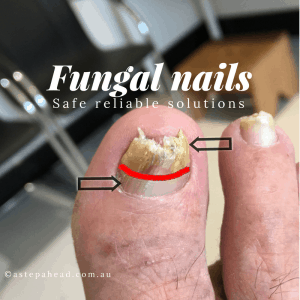
Laser therapy for fungal nails
So how can we help?
If you feel you may have a fungal nail and would like to finally get on top of things we would love to be able to help! We have now helped hundreds of patients just like you beat their nasty fungal nail condition and we’d like to be able to help you as well!
We are located in Sydney’s Western suburbs, unlike Macquarie street where parking is 65 dollars an hour our parking is free and out the front! We are conveniently located minutes off the M4!
Please call our smiley and friendly clinic staff who can help you through the process and answer any questions we haven’t on 96732987 or 47322007.

Blog, Uncategorized
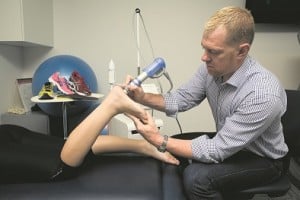
Heel pain treatment cuts down recovery time
Shock wave therapy is a relatively new treatment option used for musculoskeletal conditions. This treatment was initially seen in hospitals for “breaking down” kidney stones that were too large to pass. A Step Ahead Foot and Ankle care has found it particularly helpful for HEEL PAIN.
Now the technology has been modified so that the high pressured acoustic shockwaves travel through the skin to stimulate blood flow to the injured area which speeds up our own healing processes within our body for tissue repair.
A Step Ahead Foot and Ankle care were one of the first clinics in Sydney to try this effective new technology and have found it to be highly successful.
What conditions is it suitable for?
Shock wave is commonly used for musculoskeletal conditions, some examples include:
- Heel pain / plantar fasciitis.
- Achilles tendonitis / tendonosis
- Patella tendonopathy.
- Shin pain / Shin splints.
The Podiatrist at A Step Ahead Foot and Ankle care will be able to tell you if your problem is suitable for this treatment.
What does it feel like?
Pressure is pushed on the injured area with the probe. The shockwave treatment will feel a little uncomfortable like short bursts of throbbing sensations through the probe. Almost 100% of our patients while first a little hesitant have found this to be much better than first thought.
How can A Step Ahead Help you?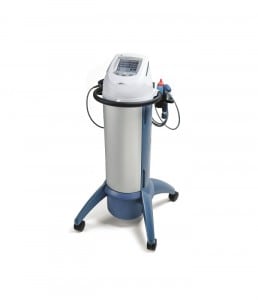
A Step Ahead Foot + Ankle care have had many years of experience using this technology and have become a leader in this field. With years of experience with this technology combined with almost 20 years of clinical practice experience you are in good hands
Resolution of pain is most often achieved through a combination of treatments this may include:
- Assessment of foot and leg mechanics
- Activity modification
- Footwear advice
- Orthotic therapy
- Stretching exercises
- Taping
Please call our helpful reception staff to make an appointment and be sure to mention your interest in the exciting new technology. 9673 2987 or 43322007




















 Dr Brenden’s White paper report on the “6 Reasons You Won’t Beat Heal Pain” outlines what’s stopping you from beating this and tips on how to stop it in its tracks!
Dr Brenden’s White paper report on the “6 Reasons You Won’t Beat Heal Pain” outlines what’s stopping you from beating this and tips on how to stop it in its tracks!